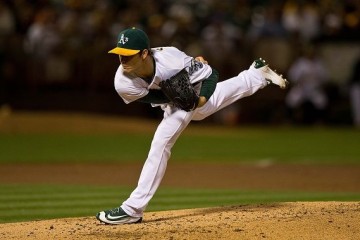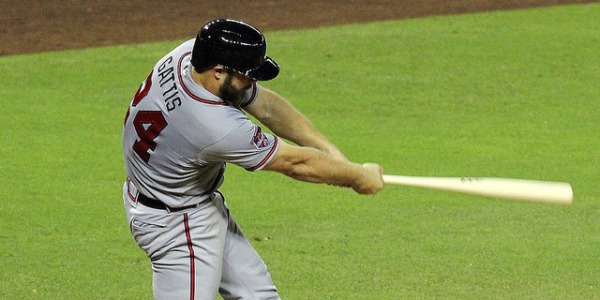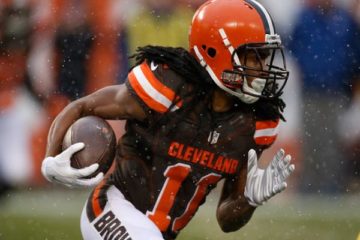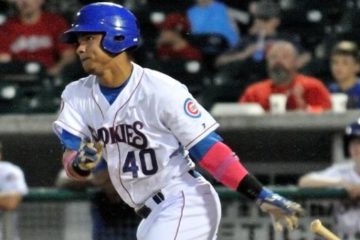2014 Fantasy Baseball: Rotters and Sleepers – Catchers
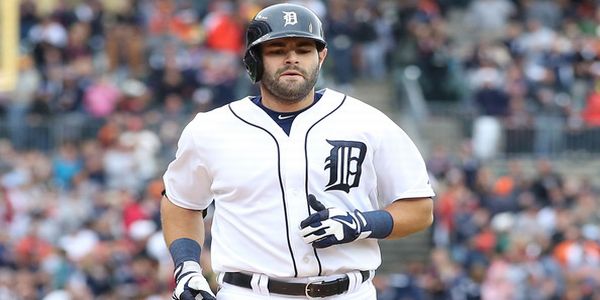

Success in fantasy baseball (or sports in general) depends greatly on recognizing inefficiencies in the market and in managing risk. Every good fantasy owner takes some risks on draft day. The question is whether they are intelligent risks or foolish risks. The buzz word around all fantasy sports is in the search for so-called “sleepers.” Sleepers are players that have underperformed in the past for one reason or another, but seemed destined to have a breakout season.
Identifying sleepers isn’t easy. Sometimes, good players have down seasons and then bounce right back up. Sometimes those same players have a down season and then their career evaporates before their very eyes. Those players are what we would call rotters. The idea is that when you find a player sleeping in the woods they may either be sleeping or dead. In February it can be hard to tell the difference. So, we will look at a few players at each position to see if we can determine the difference.
I started a series last year at this time and it seemed prudent to bring it back. Most of the players I’m identifying are players that will likely be picked towards the end of most drafts. Some will not be selected at all. Even when we are talking waiver claims, we must be careful, because every roster spot is valuable. We can’t afford to waste it on someone that likely is on their way out.
Ryan Hanigan—Tampa Bay Rays
Hanigan is the kind of player that fits the Rays perfectly. They added James Loney and Yunel Escobar last season and both worked out. Hanigan is a defensive first catcher, but prior to 2013, he performed reasonably well at the plate. At least, he performed well enough to be a backup fantasy catcher. Last year, he fell off the table, so the Reds dealt him for a bag of magic beans and the Rays seem poised to make him their primary catcher. Are they nuts?
|
AVG |
HR |
R |
RBI |
SB |
|
| 2011 |
.267 |
6 |
27 |
31 |
0 |
| 2012 |
.274 |
2 |
25 |
24 |
0 |
| 2013 |
.198 |
2 |
17 |
21 |
0 |
Admittedly, nobody was going to jump for joy at the numbers from 2011 and 2012 either, but when you look at the percentage numbers, they were good enough to keep on your bench. Certainly, the idea behind good backups is simply to hold everything together while the starter is out. The problem with Hanigan’s line of production was that he never had more than 371 plate appearances in a season. That was because Devin Mesoraco was eating into his playing time. Now, he has the opportunity to earn 400 or more plate appearances. The key to determining if he can get it back is by looking at the plate discipline and batted ball statistics to see if we can see why his sudden decline occurred.
|
SO% |
BB% |
OSwing |
Contact |
BABIP |
|
| 2011 |
10.5 |
11.5 |
25.2 |
93.1 |
.285 |
| 2012 |
10.0 |
11.9 |
24.9 |
90.4 |
.302 |
| 2013 |
10.4 |
11.2 |
25.4 |
90.8 |
.216 |
It used to be that we would look directly at batting average on balls in play (BABIP) and simply go from there, but it is important to look at the whole picture when looking at players like this. Looking at both the plate discipline numbers and batted ball statistics helps us indicate whether the dip in BABIP has any staying power. At first glance, we see there is very little if any slippage in his plate discipline, so we better check the batted ball statistics.
|
LD% |
GB% |
FB% |
ISO |
HR/FB |
|
| 2011 |
21.6 |
48.3 |
30.2 |
.090 |
8.6 |
| 2012 |
21.2 |
53.0 |
25.8 |
.063 |
2.7 |
| 2013 |
21.5 |
49.2 |
29.2 |
.063 |
3.5 |
As we can see from the batted ball statistics, you can see that there is no good reason why he should have seen such a huge dip in BABIP. We really don’t even have to know whether the figures above are good or not. We just know that there is not enough of a change to indicate the huge change in BABIP. Add about 70 points to his batting average and you have a .268 average (not to mention an additional 70 points in OBP and slugging percentage).
Grade: Sleeper
Alex Avila—Detroit Tigers
Avila is in a different situation. He has had two consecutive down campaigns after what appeared to be a breakout campaign in 2011. So, the early hypothesis would have 2011 as a career year and the rest to be more or less his norm. Still, we want to evaluate the data to make sure we won’t have a return of 2011 before giving up on him.
|
AVG |
HR |
R |
RBI |
SB |
|
| 2011 |
.295 |
19 |
63 |
82 |
3 |
| 2012 |
.243 |
9 |
42 |
48 |
0 |
| 2013 |
.227 |
11 |
39 |
47 |
0 |
Avila’s 2011 campaign wasn’t exactly Buster Posey territory, but it was enough to make him a top five fantasy catcher in most people’s 2012 drafts. After the last two seasons, he probably won’t be picked in anyone’s draft. The question is whether 2011 was a complete aberration or whether there is reason to believe we could see a comeback.
|
SO% |
BB% |
OSwing |
Contact |
BABIP |
|
| 2011 |
23.8 |
13.2 |
24.8 |
75.9 |
.366 |
| 2012 |
24.0 |
14.1 |
20.9 |
74.1 |
.313 |
| 2013 |
29.6 |
11.6 |
21.2 |
71.9 |
.305 |
These numbers don’t look promising. We see an out of context BABIP season in 2011 when he had those career numbers. Meanwhile, his strikeout rate steady increased and his contact rate steadily decreased. This all points towards 2011 being that career year that won’t likely return. That being said, his walk rates have been very good overall, so he may still have some fantasy value depending on what we find with the batted ball data.
|
LD% |
GB% |
FB% |
ISO |
HR/FB |
|
| 2011 |
21.7 |
37.8 |
40.5 |
.211 |
13.8 |
| 2012 |
23.8 |
46.4 |
29.9 |
.142 |
11.4 |
| 2013 |
28.0 |
42.2 |
29.8 |
.148 |
16.9 |
The bolded numbers are the key. Groundballs usually result in more hits than fly balls, but catchers are a different breed. Since they are slower, those ground balls more often turn into outs. So, even though his line drive rate was outrageously high last season, the higher ground ball rates are hurting him. That fly ball rate also helps explain the higher isolated power numbers from 2011. So, in the case of Alex Avila, we can explain the drop off in production.
Grade: Rotter
Miguel Montero—Arizona Diamondbacks
Most people considered Miguel Montero a top five fantasy catcher coming into last season. Those fantasy players were largely disappointed last season when Montero fell on his face. Funny, that seemed to happen to a number of Diamondbacks last season. Funny how a largely individual sport saw numerous players from the same team have a down season. I suppose there is something to this whole serendipity of good teams all having players having good years.
|
AVG |
HR |
R |
RBI |
SB |
|
| 2011 |
.282 |
18 |
65 |
86 |
1 |
| 2012 |
.286 |
15 |
65 |
88 |
0 |
| 2013 |
.230 |
11 |
44 |
42 |
0 |
Given the fact that he has had very solid seasons in two out of the last three years, Montero would seem to be the best candidate to bounce back from his bad season. Pre-season rankings seem to bear that out as he is being drafted much lower than the other two catchers we featured. Like with the others, the key is to see if he saw any significant slippage in any of the plate discipline or batted ball statistics a year ago.
|
SO% |
BB% |
OSwing |
Contact |
BABIP |
|
| 2011 |
17.5 |
8.5 |
35.2 |
80.2 |
.317 |
| 2012 |
22.7 |
12.7 |
29.8 |
75.5 |
.362 |
| 2013 |
23.2 |
10.7 |
31.9 |
74.5 |
.282 |
Again, some other numbers come into play here in addition to the dreaded BABIP. Sure, his BABIP in 2013 was lower than the previous two seasons, but his 2012 BABIP was unsustainable anyway. When you look at that BABIP in conjunction with his 2012 basic numbers you see that his 2012 season was largely a mirage itself. The problem is that his strikeout rate went up. More alarmingly, the contact rates went down even though he was swinging at a lower percentage of balls outside the zone. That indicates that we might be looking at a dip in his bat speed. He will turn 31 in March. That seems young, but most catchers suffer from fairly significant decline phases in their early thirties.
|
LD% |
GB% |
FB% |
ISO |
HR/FB |
|
| 2011 |
21.9 |
42.2 |
35.9 |
.187 |
12.6 |
| 2012 |
20.9 |
43.0 |
36.0 |
.152 |
11.6 |
| 2013 |
21.4 |
47.2 |
31.4 |
.114 |
11.3 |
Yes, his home runs per fly ball rate dropped slightly over the past three years, the biggest dip came in the fly ball rate itself. We saw the same thing with Alex Avila. In general, ground ball rates are the death of catchers. We would love to see it in players like Billy Hamilton, but the slow legs just don’t mix well with ground balls. Unfortunately for the Diamondbacks, they are committed to Montero through the 2017 season. It looks like his 2013 campaign will be more in line with his future than the previous two campaigns.
Grade: Rotter



